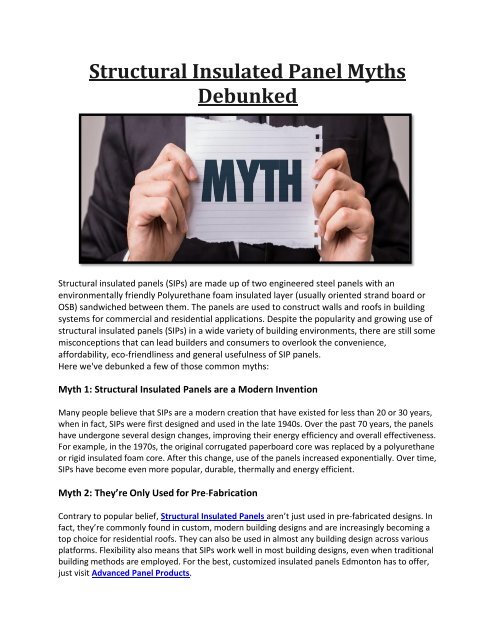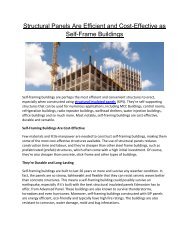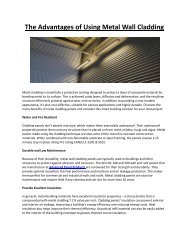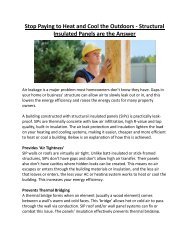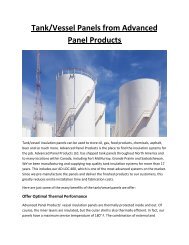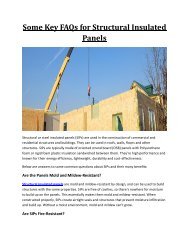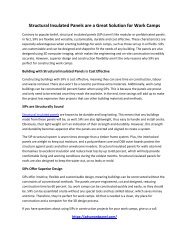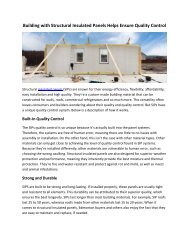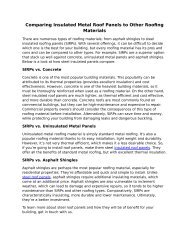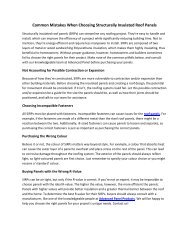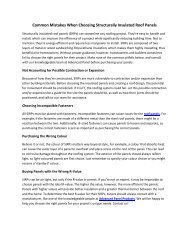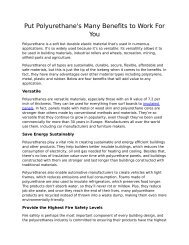Structural Insulated Panel Myths Debunked
Here are some common myths that can lead builders and consumers to overlook the convenience and affordability of Structural Insulated Panels.
Here are some common myths that can lead builders and consumers to overlook the convenience and affordability of Structural Insulated Panels.
Create successful ePaper yourself
Turn your PDF publications into a flip-book with our unique Google optimized e-Paper software.
<strong>Structural</strong> <strong>Insulated</strong> <strong>Panel</strong> <strong>Myths</strong><br />
<strong>Debunked</strong><br />
<strong>Structural</strong> insulated panels (SIPs) are made up of two engineered steel panels with an<br />
environmentally friendly Polyurethane foam insulated layer (usually oriented strand board or<br />
OSB) sandwiched between them. The panels are used to construct walls and roofs in building<br />
systems for commercial and residential applications. Despite the popularity and growing use of<br />
structural insulated panels (SIPs) in a wide variety of building environments, there are still some<br />
misconceptions that can lead builders and consumers to overlook the convenience,<br />
affordability, eco-friendliness and general usefulness of SIP panels.<br />
Here we've debunked a few of those common myths:<br />
Myth 1: <strong>Structural</strong> <strong>Insulated</strong> <strong>Panel</strong>s are a Modern Invention<br />
Many people believe that SIPs are a modern creation that have existed for less than 20 or 30 years,<br />
when in fact, SIPs were first designed and used in the late 1940s. Over the past 70 years, the panels<br />
have undergone several design changes, improving their energy efficiency and overall effectiveness.<br />
For example, in the 1970s, the original corrugated paperboard core was replaced by a polyurethane<br />
or rigid insulated foam core. After this change, use of the panels increased exponentially. Over time,<br />
SIPs have become even more popular, durable, thermally and energy efficient.<br />
Myth 2: They’re Only Used for Pre-Fabrication<br />
Contrary to popular belief, <strong>Structural</strong> <strong>Insulated</strong> <strong>Panel</strong>s aren’t just used in pre-fabricated designs. In<br />
fact, they’re commonly found in custom, modern building designs and are increasingly becoming a<br />
top choice for residential roofs. They can also be used in almost any building design across various<br />
platforms. Flexibility also means that SIPs work well in most building designs, even when traditional<br />
building methods are employed. For the best, customized insulated panels Edmonton has to offer,<br />
just visit Advanced <strong>Panel</strong> Products.
Myth 3: SIPs are Expensive<br />
Fortunately, SIPs aren’t as expensive as some builders and consumers might believe. They’re<br />
actually some of the most affordable building systems on the market. Innovative engineered<br />
designs, fast, easy construction (on-site, if needed), energy efficiency and eco-friendliness provide<br />
less waste, reduced labour, material and overall costs, as well as significant energy savings.<br />
Advantages like reduced labour and labour costs or on site assembly are especially beneficial to<br />
builders or contractors. Finally, because SIP buildings can be so energy efficient, they’re generally<br />
inexpensive to heat or cool.<br />
Ready to learn more about the many benefits of building with structural insulated panels? Call us:<br />
(780) 955-6363.


